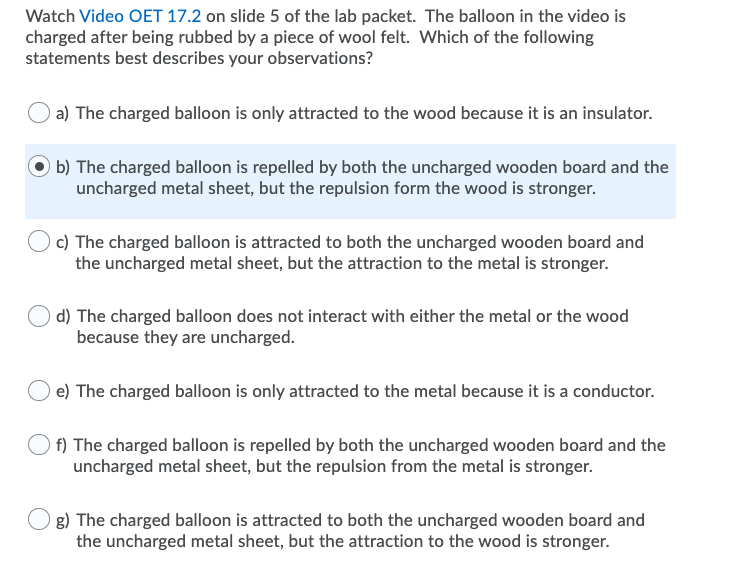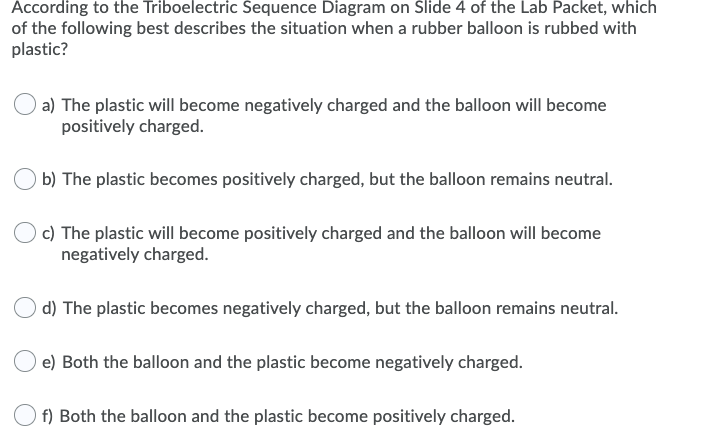Watch Video OET 17.2 on slide 5 of the lab packet. The balloon in the video is charged after being rubbed by a piece of wool felt. Which of the following statements best describes your observations? a) The charged balloon is only attracted to the wood because it is an insulator. b) The charged balloon is repelled by both the uncharged wooden board and the uncharged metal sheet, but the repulsion form the wood is stronger. c) The charged balloon is attracted to both the uncharged wooden board and the uncharged metal sheet, but the attraction to the metal is stronger. d) The charged balloon does not interact with either the metal or the wood because they are uncharged. e) The charged balloon is only attracted to the metal because it is a conductor. f) The charged balloon is repelled by both the uncharged wooden board and the uncharged metal sheet, but the repulsion from the metal is stronger. g) The charged balloon is attracted to both the uncharged wooden board and the uncharged metal sheet, but the attraction to the wood is stronger.
Watch Video OET 17.2 on slide 5 of the lab packet. The balloon in the video is charged after being rubbed by a piece of wool felt. Which of the following statements best describes your observations? a) The charged balloon is only attracted to the wood because it is an insulator. b) The charged balloon is repelled by both the uncharged wooden board and the uncharged metal sheet, but the repulsion form the wood is stronger. c) The charged balloon is attracted to both the uncharged wooden board and the uncharged metal sheet, but the attraction to the metal is stronger. d) The charged balloon does not interact with either the metal or the wood because they are uncharged. e) The charged balloon is only attracted to the metal because it is a conductor. f) The charged balloon is repelled by both the uncharged wooden board and the uncharged metal sheet, but the repulsion from the metal is stronger. g) The charged balloon is attracted to both the uncharged wooden board and the uncharged metal sheet, but the attraction to the wood is stronger.
Principles of Physics: A Calculus-Based Text
5th Edition
ISBN:9781133104261
Author:Raymond A. Serway, John W. Jewett
Publisher:Raymond A. Serway, John W. Jewett
Chapter19: Electric Forces And Electric Fields
Section: Chapter Questions
Problem 15CQ: A common demonstration involves charging a rubber balloon, which is an insulator, by rubbing it on...
Related questions
Question

Transcribed Image Text:Watch Video OET 17.2 on slide 5 of the lab packet. The balloon in the video is
charged after being rubbed by a piece of wool felt. Which of the following
statements best describes your observations?
a) The charged balloon is only attracted to the wood because it is an insulator.
b) The charged balloon is repelled by both the uncharged wooden board and the
uncharged metal sheet, but the repulsion form the wood is stronger.
c) The charged balloon is attracted to both the uncharged wooden board and
the uncharged metal sheet, but the attraction to the metal is stronger.
d) The charged balloon does not interact with either the metal or the wood
because they are uncharged.
e) The charged balloon is only attracted to the metal because it is a conductor.
f) The charged balloon is repelled by both the uncharged wooden board and the
uncharged metal sheet, but the repulsion from the metal is stronger.
g) The charged balloon is attracted to both the uncharged wooden board and
the uncharged metal sheet, but the attraction to the wood is stronger.

Transcribed Image Text:According to the Triboelectric Sequence Diagram on Slide 4 of the Lab Packet, which
of the following best describes the situation when a rubber balloon is rubbed with
plastic?
a) The plastic will become negatively charged and the balloon will become
positively charged.
b) The plastic becomes positively charged, but the balloon remains neutral.
c) The plastic will become positively charged and the balloon will become
negatively charged.
d) The plastic becomes negatively charged, but the balloon remains neutral.
e) Both the balloon and the plastic become negatively charged.
f) Both the balloon and the plastic become positively charged.
Expert Solution
This question has been solved!
Explore an expertly crafted, step-by-step solution for a thorough understanding of key concepts.
This is a popular solution!
Trending now
This is a popular solution!
Step by step
Solved in 3 steps

Knowledge Booster
Learn more about
Need a deep-dive on the concept behind this application? Look no further. Learn more about this topic, physics and related others by exploring similar questions and additional content below.Recommended textbooks for you

Principles of Physics: A Calculus-Based Text
Physics
ISBN:
9781133104261
Author:
Raymond A. Serway, John W. Jewett
Publisher:
Cengage Learning

Physics for Scientists and Engineers, Technology …
Physics
ISBN:
9781305116399
Author:
Raymond A. Serway, John W. Jewett
Publisher:
Cengage Learning

Physics for Scientists and Engineers: Foundations…
Physics
ISBN:
9781133939146
Author:
Katz, Debora M.
Publisher:
Cengage Learning

Principles of Physics: A Calculus-Based Text
Physics
ISBN:
9781133104261
Author:
Raymond A. Serway, John W. Jewett
Publisher:
Cengage Learning

Physics for Scientists and Engineers, Technology …
Physics
ISBN:
9781305116399
Author:
Raymond A. Serway, John W. Jewett
Publisher:
Cengage Learning

Physics for Scientists and Engineers: Foundations…
Physics
ISBN:
9781133939146
Author:
Katz, Debora M.
Publisher:
Cengage Learning

College Physics
Physics
ISBN:
9781285737027
Author:
Raymond A. Serway, Chris Vuille
Publisher:
Cengage Learning

College Physics
Physics
ISBN:
9781305952300
Author:
Raymond A. Serway, Chris Vuille
Publisher:
Cengage Learning

College Physics
Physics
ISBN:
9781938168000
Author:
Paul Peter Urone, Roger Hinrichs
Publisher:
OpenStax College